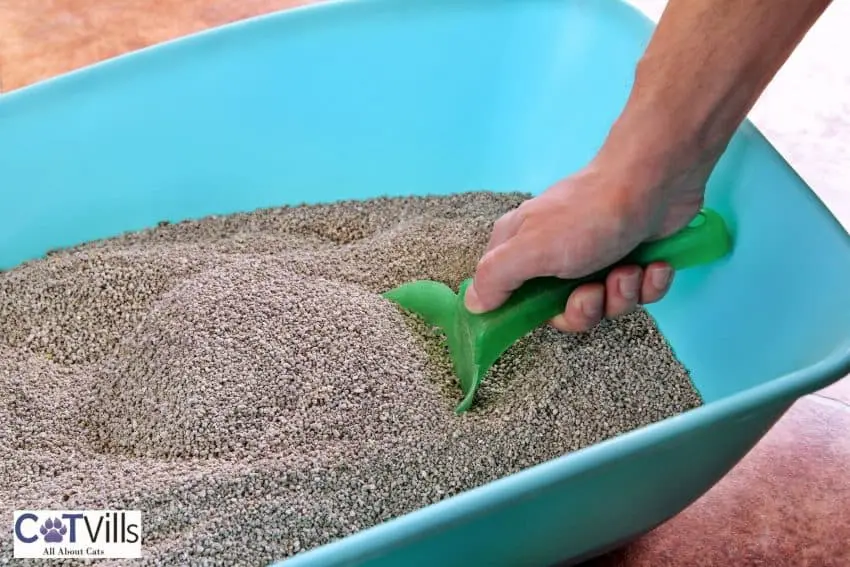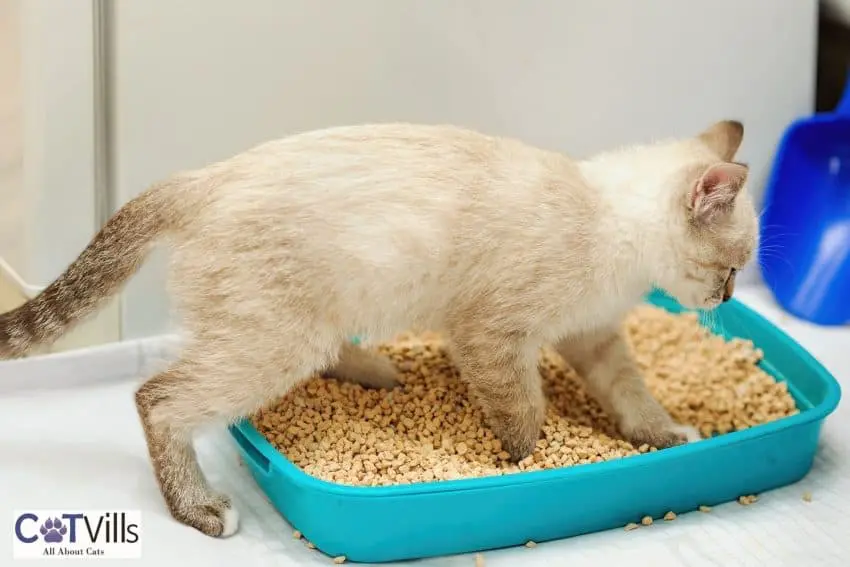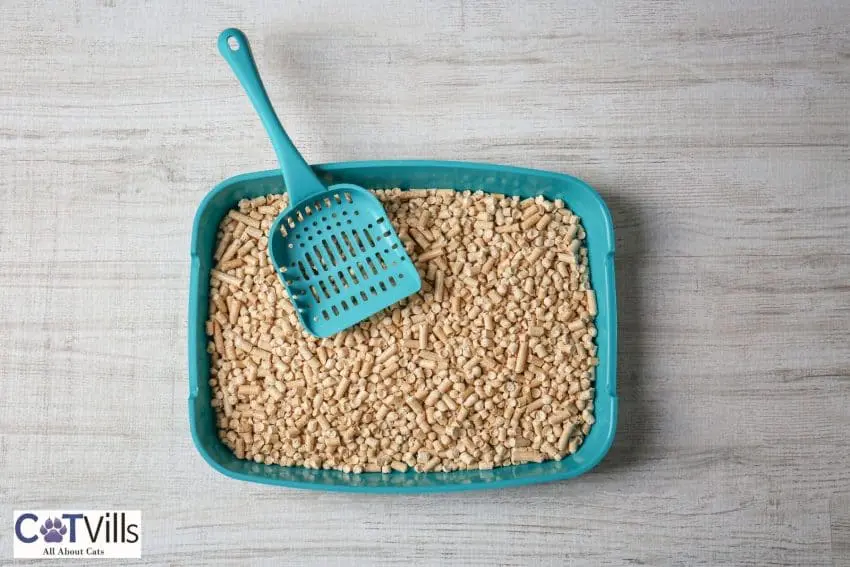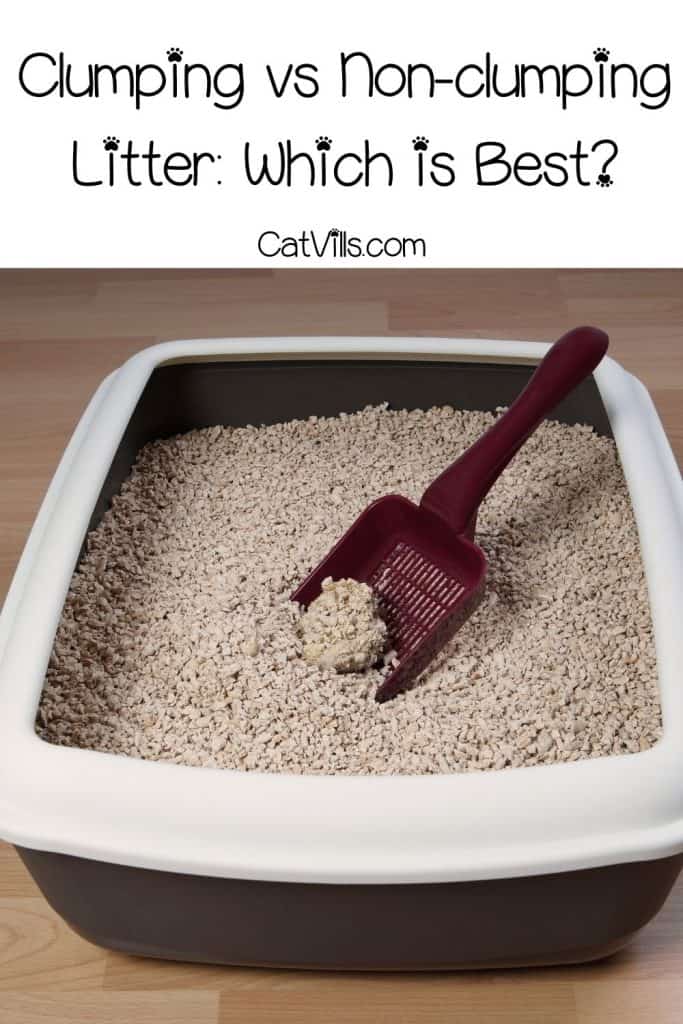Last Updated: 10 months ago
These are the main types of cat litter today’s cat parents use.
Keep reading if you’re at a crossroads about which type is best to buy for your kitty.
We’ve put together this guide to give you insightful tips about these types of litter, how they work, and their benefits, so you can make an informed decision.
What Is Clumping Cat Litter?

Clumping cat litter is litter made of natural minerals that absorb moisture to form clumps. These minerals start clumping when in contact with a cat’s liquid waste.
When making clumping cat litter, bentonite clay is mixed with other ingredients like sodium bentonite and Fuller’s earth.
These materials create an ionic bond with wet litter, allowing it to absorb up to 3.5 times its weight in liquid.
How Does Clumping Litter Work?
The clay particles absorb the moisture when your cat urinates or defecates in the clumping litter. These particles then start to bind together, forming clumps of solid waste.
I realized that clumping cat litter made my work easier. Instead of cleaning the entire cat litter box, I just scoop out the solid clumps leaving the clean litter behind.
The significant distinction between non-clumping clay litter vs. clumping litter is that the latter forms clumps of solid waste in contact with moisture.
It’s worth noting that clay makes both clumping and non-clumping cat litters.
Due to its efficiency in absorbing moisture, clumping cat litter is sometimes used to soak up oil spills in the garage.
Clumping Litter Benefits

- It is easy to clean: As a pet owner, you don’t have to change the entire contents of the cat box, which is labor-intensive. All you need to do is remove the soiled clumps of cat pee and feces.
- It controls unpleasant odors effectively: The higher absorbency rate means there’s less of a chance for bad smells to develop.
- It is less expensive: Since the litter clumps, it does not use as much litter, which means you will go through it more slowly, costing you less.
Drawbacks of Clumping Cat Litter
- It is initially more expensive: The initial cost of a back of clumping litter will cost more than a non-clumping one. This is because they contain bentonite clay, which is an expensive natural absorbent. However, over the long term, you use less, potentially saving money.
- Tracking: Clumping litters tend to track more than non-clumping ones. The clumps can stick to your cat’s paws and be carried out of the litter tray.
- Cat health problems: When cats use the litter box, they lick themselves clean, and in the process, they may ingest the hard clumps. These clumps coat the cat’s internal organs, which leads to issues like lethargy, diarrhea, and vomiting.
Types of Clumping Cat Litter
There are two types of clumping cat litter:
- Clay-based clumping cat litter
- Silica gel-based clumping kitty litter
Clay-Based Clumping Kitty Litter
This is the most common type of clumping cat litter made of bentonite clay, a natural absorbent. Clay-based clumping kitty litters are usually more affordable than silica gel-based ones.
The main advantage of using clay-based clumping cat litter is its effectiveness in trapping odors. It can also absorb a large amount of urine and feces by forming tight clumps.
However, the downside of traditional clay litter cat litter is that it’s dusty and messy. The dust from the clay can irritate your cat’s respiratory system and cause health problems.
If your cat has respiratory system issues like asthma, use dust free cat litter.
Silica Gel-Based Clumping Litter
This clumping cat litter is made of silica gel, a synthetic absorbent. Silica gel clumping cat litters are more expensive than clay-based ones, but they offer many benefits.
This clumping kitty litter is dust-free, so it won’t irritate your cat’s respiratory system. Therefore, it’s the best crystal cat litter.
Silica crystals are also effective in converting cat feces and urine into clumps.
The main disadvantage of silica gel clumping cat litter is that it tracks a lot. The small beads can stick to your feline’s paws and be carried out of the box.
You may need a trackless cat litter to prevent frequent cat tracking in the house.
What Is Non-clumping Cat Litter?

Non-clumping cat litter is litter that does not form clumps when it comes in contact with cat feces and urine.
It’s made of corn kernels, wheat, shredded paper, wood, or pine that can absorb moisture without forming clumps.
Most natural cat litters are non-clumping.
How Does Non-clumping Litter Work?
The granules absorb the water when your cat urinates or defecates in a non-clumping cat litter. These granules swell up and become softer, but they do not form clumps.
As the urine gets absorbed by the non-clumping cat litter granules, feces are left intact. When cleaning the box, you’ll have to scoop out both the feces and the soiled granules.
Cat owners are advised to change non-clumping kitty litter when they notice the granules saturated with urine. In most cases, this should be done weekly.
What if you’re always busy and find it hard to make time to clean the cat box regularly? Lots of cat parents with busy lives opt for investing in self-cleaning litter robot litter.
Non-clumping Litter Benefits

- More affordable: It is usually cheaper than clumping ones because they are made from popular materials, like shredded paper, kernel corn, and wheat.
- Low tracking: They tend to track less than clumping ones. The granules are light and will not stick to your cat’s paws as easily.
- It does not cause health problems: They are made of safe materials for cats if ingested. There is no risk of your cat ingesting harmful clay particles when licking themselves clean.
Drawbacks of Non-clumping Cat Litter
- It’s less effective: Non-clumping kitty litters are not as effective at absorbing urine and feces. This means that there is a higher chance for bad smells to develop.
- It’s more labor-intensive: You will have to change the entire contents of the cat box more often because they cannot be scooped and reused like clumping kitty litters.
- Poor odor control: It is ineffective at odor control compared to the clumping options.
Types of Non-clumping Cat Litter
There are many types of non-clumping cat litter available. Some of the most popular ones include:
- Corncob litter: This type of litter is made of dried kernel corns that have been ground into small pieces. It’s absorbent and does not track too much.
- Wheat litter: It’s made of wheat grounded into small pieces.
- Shredded paper litter: This litter is made of shredded recycled paper. It’s absorbent and does not track too much.
- Wood pellet litter: It’s made of compressed wood, which is often recycled.
Clumping Vs Non-clumping Litter: Key Differences
The key difference between these litters is the formation of clumps.
The table below summarizes the differences between clumping and non-clumping cat litter:
Clumping Litter
- Forms clumps
- More expensive initially
- Made from either bentonite clay or silica gel
- Prone to tracking
Non-Clumping Litter
- Do not form clumps
- Affordable
- Made from different organic compounds like corn, wheat, shredded paper, and pine
- Tracks less
Clump Formation
Clumping cat litter forms clumps when it comes into contact with the cat’s feces and urine. The clumps absorb the moisture and odor, making it easy to scoop out and dispose of the soiled litter and retain fresh litter.
Non-clumping kitty litter, on the other hand, does not form clumps. The clay granules absorb the cat’s urine and moisture, leaving behind feces.
Because it does not form clumps, non-clumping litter is disposed of when it becomes saturated with urine. The litter box is then cleaned and refilled with fresh litter.
A clean litter box will be comfortable for your kitty at all times.
Affordability
Non-clumping cat litter is usually cheaper than clumping litter. This is because the materials used to make non-clumping litter are readily available and do not require special processing.
On the other hand, clumping litters are made of bentonite clay or silica gel crystals that are not as readily available. Bentonite clay must be mined and processed before being used in the litter.
Tracking
Non-clumping litters tend to track less than clumping litters because of their light granules. These granules do not stick to the cat’s paws easily.
On the other hand, clumping litters are made of heavier clay and silica gel crystals that are more likely to stick on the cat’s paws. As the cat leaves the tray, they’re dropped in the house.
This video goes into more depth about the difference between litters.
When Should You Choose a Clumping Litter?
If you’re looking for an absorbent litter that is easy to scoop, clumping litter is the way to go. It’s also a good choice if you have multiple cats because it can absorb more urine and feces.
Before choosing a clumping litter, you must consider the age of your feline friend. Clumping litter should only be used by a kitten older than 4 months.
It’s normal for kittens to experiment with things by putting them in their mouth. In the process, your kitten might ingest the clumping litter.
If ingested, clumping litter takes the clumping effect to the kitten’s intestines. This could cause an intestinal blockage that may be fatal to your cat.
“It is conceivable that kittens playing in the litter box for extended periods could ingest or inhale a sufficient amount of litter to be harmed,” says James Richards, DVM.
When Should You Choose a Non-clumping Litter?

If you’re looking for a gentle natural litter on your cat’s paws, then non-clumping litter is the way to go. Apart from being lightweight, non-clumping litter has minimal dust and tracks less.
Moreover, non-clumping litter is good for you if you’re budget-conscious because it’s cheaper.
Finally, if you have kittens aged below 4 months, non-clumping litter is safer. You can switch to the clumping litter once they hit 4 months old.
If you have two or more cats that urinate and frequently defecate, switch to clumping litter. This will absorb the urine quickly and eliminate odors from your house.
Clumping Vs Non-clumping Litter: Which Is the Best?
The answer to this question depends on your needs and preferences. If you’re looking for an absorbent and easy-to-scoop litter, then clumping litter is the way to go.
You’ll also need a clumping litter to eliminate ammonia gas emanating from cat urine.
However, if you’re looking for a natural and lightweight litter that tracks less without harmful additives, non-clumping litter is the best choice.
FAQs
WHAT TYPE OF CAT LITTER DO VETS RECOMMEND?
Vets recommend unscented clumping cat litter because it does not irritate cat sinuses and respiratory tract. It also does not put a cat off using its litter tray.
HOW OFTEN DO YOU CHANGE CAT LITTER PELLETS?
Change cat litter pellets at least once per month. However, if you have multiple cats, you might need to change it more often.
Final Word
Both clumping and non-clumping cat litters are beneficial in their own ways. The best type of litter for you depends on your personal preference.
I now hope you can differentiate between clumping vs. non-clumping litter and select the one that meets your cat’s needs.
Which litter do you use for your felines? Please let us know!
Resources:


